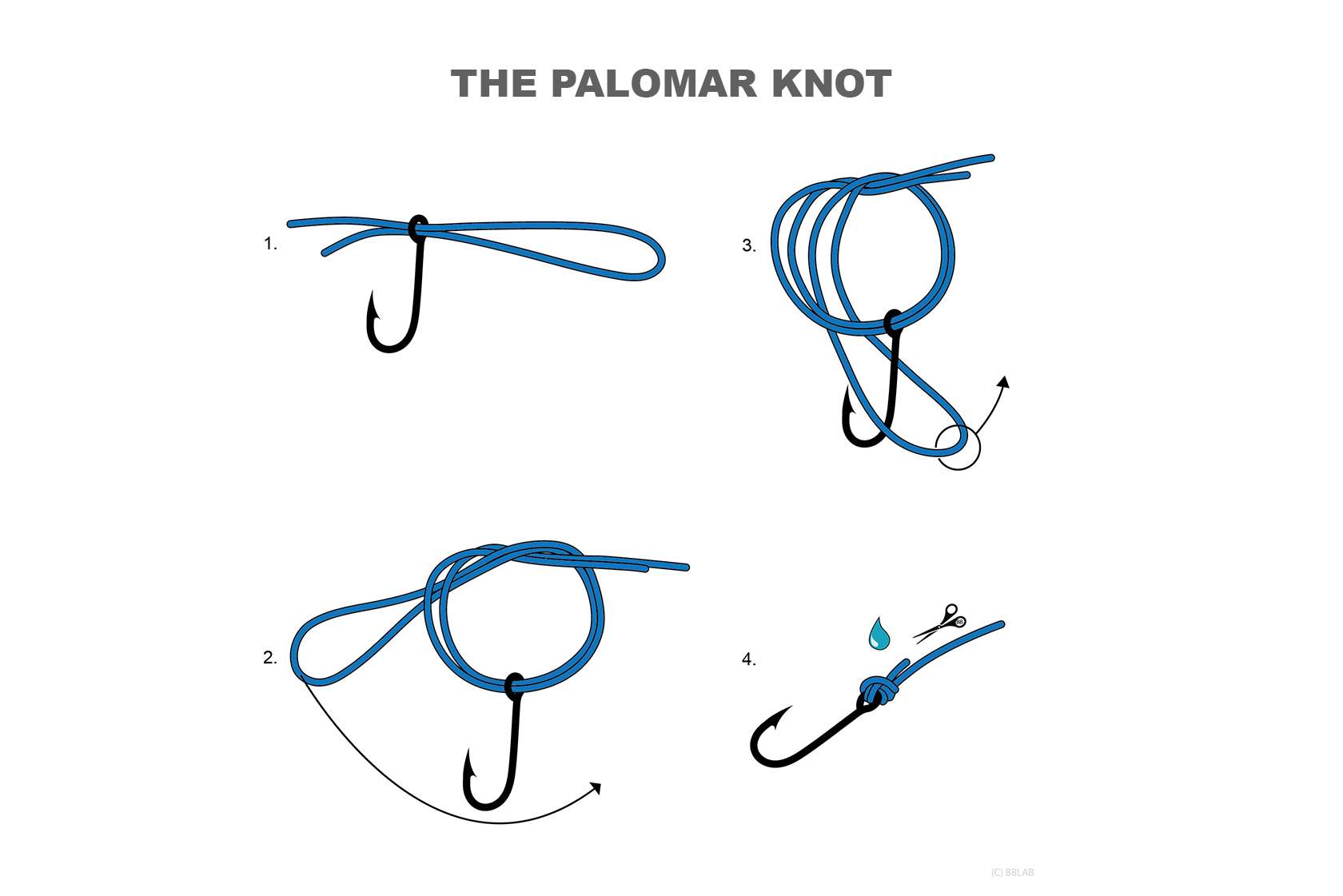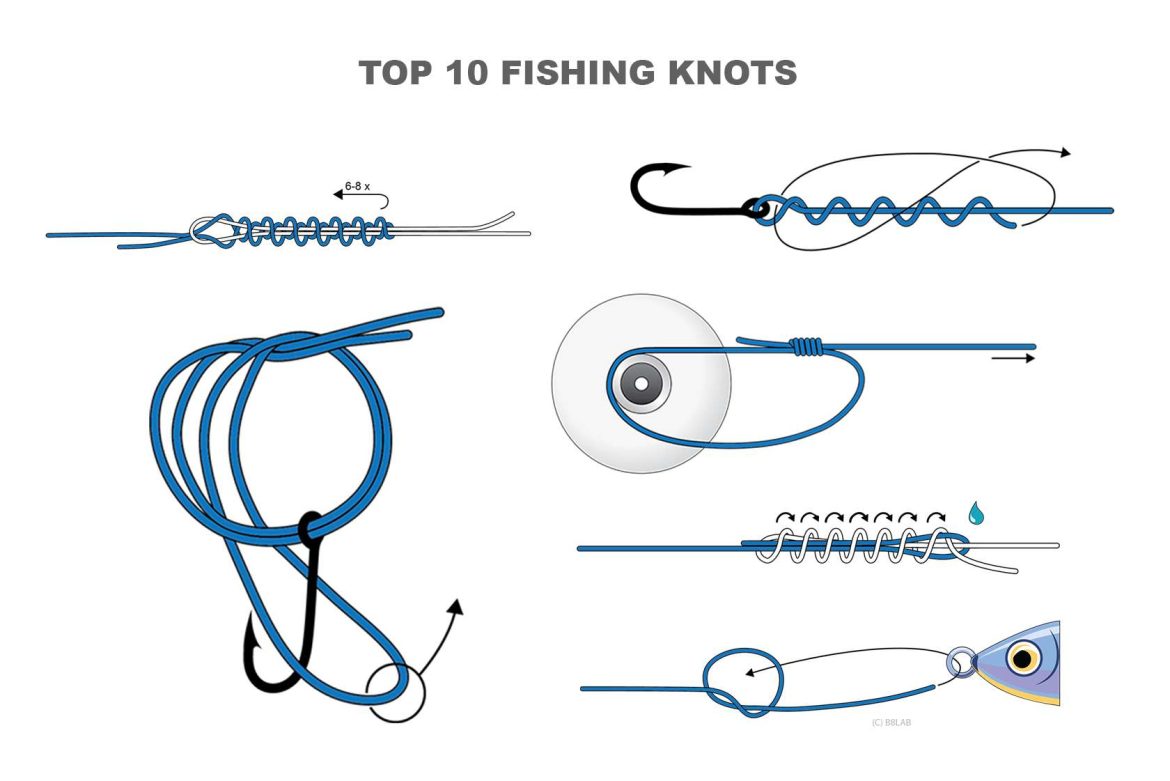Level up your bass fishing skills with the Top 10 Ultimate Bass Fishing Knots Guide! Master the top 10 essential knots for success with our easy video tutorials, pro tips, and valuable insights. Tie knots with confidence and reel in trophy-worthy catches like a pro. Get ready to conquer the water with bass fishing’s best-kept secrets. Start your knot mastery journey now!
Top 10 Fishing Knots for Bass Fishing
When it comes to bass fishing, using the right knots can make all the difference between a successful day on the water and missed opportunities. Strong and reliable knots ensure your baits stay secure, and your hooks are set firmly when the big one strikes. In this article, we’ll dive into the world of fishing knots, focusing on the ones that have proven to be most effective for bass anglers.
Quick Answer – What is a Fishing Knot?
A fishing knot is a specialized knot used to secure fishing lines to hooks, lures, swivels, or other terminal tackle. It ensures that the line remains attached to the terminal tackle during casting, retrieving, and fighting fish. Fishing knots are crucial in preventing the loss of hooks or lures and in providing the strength needed to land fish successfully.
#1. The Palomar Knot
Main Use
The Palomar Knot is perfect for tying hooks and lures to all types of fishing lines, be it monofilament, fluorocarbon, or braided lines. It’s a versatile knot that guarantees excellent knot strength and is highly favored by anglers worldwide.

✅ The Pros
Offers exceptional knot strength; easy to tie in various conditions.
❌ The Cons
Can be tricky with very small hooks or lures.
Pro Tip
Wet the knot before tightening to reduce friction and increase knot strength.
Learn more about the Palomar Knot and its step-by-step guide here
#2. The Improved Clinch Knot
Main Use
The Improved Clinch Knot is the go-to choice for securing hooks and lures to monofilament or fluorocarbon lines. It’s a classic knot that’s simple to tie and provides reliable strength, making it a staple in every angler’s knot repertoire.

✅ The Pros
Simple and reliable; widely used for different fishing applications.
❌ The Cons
May slip with braided lines, requires more wraps for added strength.
Pro Tip
Add an extra turn when using braided lines for improved security.
Learn more about the Improved Clinch Knot and its step-by-step guide here
#3. The Uni Knot (or Duncan Knot)
Main Use
The Uni Knot, also known as the Duncan Knot, is a versatile knot used for connecting hooks, lures, and swivels to various fishing lines. Its strength and ease of tying make it a favorite among anglers.

✅ The Pros
Maintains high knot strength with monofilament and fluorocarbon lines.
❌ The Cons
Tends to slip on braided lines.
Pro Tip
Double the line for added strength when using braided lines.
Learn more about the Uni Knot (Duncan Knot) and its step-by-step guide here
#4. The Snell Knot
Main Use
The Snell Knot is specifically designed for tying hooks for baitcasting setups. It improves hook-setting efficiency, making it ideal for techniques like flipping and pitching, where quick and solid hooksets are crucial.

✅ The Pros
Improves hook-setting efficiency; great for flipping and pitching techniques.
❌ The Cons
Requires practice to master the technique.
Pro Tip
Use the Snell knot for all your flipping presentations with straight shank hooks.
Learn more about the Snell Knot and its step-by-step guide here
#5. The Double Uni Knot
Main Use
The Double Uni Knot is your go-to knot for joining lines of similar or different diameters, making it perfect for attaching a fluorocarbon leader to a braided main line. Its versatility ensures a strong and reliable connection.

✅ The Pros
Quick and easy; reliable for connecting main line to leaders.
❌ The Cons
Bulkier than some other knots, which can affect casting distance.
Pro Tip
Use this knot when targeting finicky bass in clear water.
Learn more about the Double Uni Knot and its step-by-step guide here
#6. The Loop Knot
Main Use
The Loop Knot, also known as the “Non-Slip Loop Knot” or “Kreh Loop Knot,” is the choice for allowing lures to move more naturally in the water. Its free-moving loop enhances the action of lures, making it excellent for topwater presentations. Pros: Enhances the action of lures; great for topwater presentations.

✅ The Pros
Enhances the action of lures; great for topwater presentations.
❌ The Cons
Can weaken the line slightly.
Pro Tip
Use the Loop knot for all your topwater baits to increase strikes.
Learn more about the Loop Knot and its step-by-step guide here
#7. The Albright Knot
Main Use
The Albright Knot is the perfect solution for connecting different types of lines, such as braided line to fluorocarbon leaders. It provides a slim profile for smooth casting, ensuring a strong and reliable connection.

✅ The Pros
Slim profile for smooth casting; strong and reliable connection.
❌ The Cons
Requires more practice to tie correctly.
Pro Tip
Lubricate the knot before cinching down for added strength.
Learn more about the Albright Knot and its step-by-step guide here
#8. The FG Knot
Main Use
The FG Knot is the knot of choice for joining braided lines with unmatched strength. It virtually passes through guides without catching, retaining maximum line strength for battling hard-fighting bass.
✅ The Pros
Virtually passes through guides without catching; retains maximum line strength.
❌ The Cons
Can be more challenging to tie, especially in adverse weather conditions.
Pro Tip
Practice makes perfect! Learn to tie the FG knot proficiently to reap its full benefits.
Learn more about the FG Knot and its step-by-step guide here
#9. The Alberto Knot
Main Use
The Alberto Knot is a slim and reliable choice for connecting fluorocarbon or monofilament leaders to braided lines. It ensures smooth passage through guides and is highly favored for its dependable performance.

✅ The Pros
Slim and reliable; passes through guides smoothly.
❌ The Cons
Requires extra care while tightening to avoid slippage.
Pro Tip
Wet the knot thoroughly and cinch down slowly for optimal performance.
Learn more about the Alberto Knot and its step-by-step guide here
#10. The Spool Knot
Main Use
The Spool Knot is primarily used to secure your fishing line to the spool of your reel. It ensures a firm connection, reducing the chances of line slippage and ensuring smooth casting and retrieving.

✅ The Pros
- Provides a strong and reliable knot to keep your line in place.
- Prevents tangles and twists in the line during casting and retrieval.
- Easy to tie, making it suitable for anglers of all experience levels.
❌ The Cons
- May require a bit of practice initially to get the tension right.
- If not properly tightened, the knot might slip, leading to potential line issues.
Pro Tip
Before fully tightening the knot, moisten it with water or saliva. This helps reduce friction during tightening and ensures a snug, secure knot. Also, ensure the wraps are neat and tight to enhance the knot’s strength.
Learn more about the Spool Knot and its step-by-step guide here
Did You Know? 3 Fun Facts About Knots
Let’s uncover some fascinating facts about fishing knots:
- Ancient Origins: Fishing knots have a long history dating back thousands of years. Archaeological evidence suggests that ancient fishermen used knots made from plant fibers and animal sinews to secure hooks and lines for catching fish, showcasing the early ingenuity of our ancestors in pursuing aquatic sustenance.
- Knots for Every Line: Different fishing lines require specific knots to maximize their potential. For instance, braided lines demand strong knots like the Palomar or FG knot, while monofilament lines work best with the Improved Clinch Knot. Adapting the right knot for each line type ensures optimal performance and reduces the risk of losing a prized catch.
- Record-Breaking Knot Strength: Modern fishing knots have achieved remarkable strength feats. One example is the Bimini Twist knot, which is often used in big game fishing. It can maintain over 90% of the line’s original strength, making it ideal for battling massive fish species like marlins and tuna. The development of such powerful knots has opened new doors for anglers seeking to tackle larger and more challenging catches.
Conclusion
By mastering these popular bass fishing knots and following our pro tips, you’ll be well-equipped to tackle any bass fishing adventure. Secure your hooks and lures like a seasoned angler, and get ready to reel in those trophy bass like never before.
Now, let’s dive into each knot with detailed step-by-step guides and video tutorials to tie them like a pro! Simply click the link under the individual knots to open the detailed article and tutorial.
Have fun, tight lines and enjoy the great outdoors!
Amazing Links
- Ready to discover the surprising world of largemouth bass? Check out our article on “50 fun and shocking facts about largemouth bass” and get hooked! Link: 50 Fun Facts About Bass
- Want to make sure the bass you catch survive and thrive? Learn the right way to catch and release them with our informative guide. Link: How To Catch And Release Bass
- Are you curious about what largemouth bass eat? Our article “What do Bass eat?” has all the answers and might just surprise you. Link: What Do Largemouth Bass Eat
Catch us on Instagram
Get stunning photos, expert tips, and engaging stories that will take your fishing game to the next level. Don’t miss out and follow us on Instagram today!


1 Comment
Pingback: Fishing Knots: The Snell Knot - Ultimate Guide - B8LAB Fishing Blog